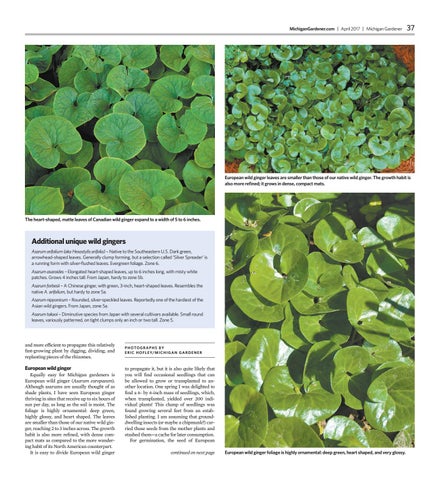MichiganGardener.com | April 2017 | Michigan Gardener
37
European wild ginger leaves are smaller than those of our native wild ginger. The growth habit is also more refined; it grows in dense, compact mats.
The heart-shaped, matte leaves of Canadian wild ginger expand to a width of 5 to 6 inches.
Additional unique wild gingers Asarum arifolium (aka Hexastylis arifolia) – Native to the Southeastern U.S. Dark green, arrowhead-shaped leaves. Generally clump forming, but a selection called ‘Silver Spreader’ is a running form with silver-flushed leaves. Evergreen foliage. Zone 6. Asarum asaroides – Elongated heart-shaped leaves, up to 6 inches long, with misty white patches. Grows 4 inches tall. From Japan, hardy to zone 5b. Asarum forbesii – A Chinese ginger, with green, 3-inch, heart-shaped leaves. Resembles the native A. arifolium, but hardy to zone 5a. Asarum nipponicum – Rounded, silver-speckled leaves. Reportedly one of the hardiest of the Asian wild gingers. From Japan, zone 5a. Asarum takaoi – Diminutive species from Japan with several cultivars available. Small round leaves, variously patterned, on tight clumps only an inch or two tall. Zone 5.
and more efficient to propagate this relatively fast-growing plant by digging, dividing, and replanting pieces of the rhizomes.
European wild ginger Equally easy for Michigan gardeners is European wild ginger (Asarum europaeum). Although asarums are usually thought of as shade plants, I have seen European ginger thriving in sites that receive up to six hours of sun per day, as long as the soil is moist. The foliage is highly ornamental: deep green, highly glossy, and heart shaped. The leaves are smaller than those of our native wild ginger, reaching 2 to 3 inches across. The growth habit is also more refined, with dense compact mats as compared to the more wandering habit of its North American counterpart. It is easy to divide European wild ginger
P H OTO G R A P H S BY E R I C H O F L E Y/ M I C H I G A N G A R D E N E R
to propagate it, but it is also quite likely that you will find occasional seedlings that can be allowed to grow or transplanted to another location. One spring I was delighted to find a 6- by 6-inch mass of seedlings, which, when transplanted, yielded over 200 individual plants! This clump of seedlings was found growing several feet from an established planting. I am assuming that grounddwelling insects (or maybe a chipmunk?) carried those seeds from the mother plants and stashed them—a cache for later consumption. For germination, the seed of European continued on next page
European wild ginger foliage is highly ornamental: deep green, heart shaped, and very glossy.
